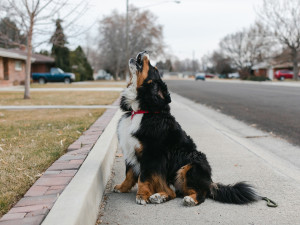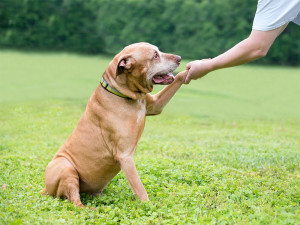Do Dogs Understand Our Words?
Say what? A look at the types of words that dogs understand

Share Article
What do words mean to dogs? Do you sound like you’re speaking nonsense or does your dog genuinely understand your words? Are dogs on the same page as us, or even in the same book? We delve into dogs’ understanding of human language.
How much do people think dogs understand? A lot. According to a study by Péter Pongrácz and his colleagues at the Family Dog Project in Budapest. Thirty-seven owners provided a list of 430 different utterances that they thought their dogs knew, with each owner providing an average of 30 phrases.

littleKin™ is Kinship’s home just for puppy and kitten parents. Bop over to check out expert advice, new pet tools, and special deals—all curated for your newest family member.
opens in a new tabSome dogs like Chaser (the dog who knows 1,000+ words) are celebrated for their panache for human language. The media hails them as ‘super-smart‘, and after meeting Chaser, astrophysicist Neil deGrasse Tyson exclaimed, “Who would have thought that animals are capable of this much display of intellect?” So, what are these dogs doing with words?
Let’s look at the types of words that dogs understand
Objects
Dogs can learn the names of many different objects. Julia Fischer, group leader at the German Primate Center’s Cognitive Ethology Lab, heard that a Border Collie named Rico knew the names of 70 individual objects, and she wanted to know how Rico mapped specific human words to particular objects. “I contacted the owners, and they let us visit their home and start a study of Rico,” explains Julia. This culminated in 2004 with an article in Science, reporting that Rico knew the names of over 200 different objects.
Seven years later, Chaser, a Border Collie in South Carolina, took the gold medal when Alliston Reid and John Pilley of Wofford College reported that Chaser knew the distinct names of 1,022 objects – more than 800 cloth animals, 116 balls, 26 Frisbees and 100 plastic items. This is not merely a story about Border Collies, however. There’s also Bailey, a 12-year-old Yorkshire Terrier, that researchers found knew the names of about 120 toys.
Dogs also win praise for their ability to learn and retain the names of new objects. When presented with a group of toys, all of which were familiar except one, both Chaser and Rico could retrieve the unknown toy when asked to fetch using an unfamiliar word. In essence, the dogs were pairing a novel object with an unfamiliar name after a single association and then remembering the name of that new object in subsequent trials. In children, this is called ‘fast mapping’ and it was thought to be uniquely human. John notes, “This research shows that this understanding occurs on a single trial. However, Chaser needed additional rehearsal in order to transfer this understanding or learning into long-term memory.”
Actions
But life is not only about knowing the names of one’s stuffed animals and Frisbees. Humans often use verbs such as comeopens in a new tab, sit, down and off to get dogs to alter their behaviour. After controlling for external contextual cues, researchers found that dogs could still understand that specific words map to specific physical actions. Chaser showed an incredible amount of flexibility with actions – performing ‘take’, ‘paw’, and ‘nose’ towards different objects.
‘That’s just training,’ you might say, but this suggests that some dogs show a cognitively advanced skill where actions are understood as independent from objects. Alliston and John found that Chaser did not interpret ‘fetch sock’ as one single word, like ‘fetchsock’. Instead, she could perform a number of different fetch actions flexibly towards a number of different objects. Daniela Ramos, a veterinary behaviourist in São Paulo, discovered that a mutt named Sofia could also differentiate object names from action commands, suggesting these dogs attend to the individual meaning of each word.
Categories
Chaser could assign objects to different categories based on their physical properties; some are ‘toys’. others are ‘Frisbees’ and, of course, there are ‘balls’. Chaser takes her cue from Alex, Irene Pepperberg’s African Grey Parrot, who also learned categories like colour, shape and material and differentiated which trait was the same or different.
Is it training or something more?
This all seems quite extraordinary, but nothing comes free of controversy. Do dogs understand words the same way humans do or are they merely well-trained? For example, some researchers are not certain that dogs actually ‘fast map’; dogs might be doing something that simply looks like ‘fast mapping’ from the outside. Regardless, it does seem as though these dogs have a conception of objects and actions.
Patricia McConnell, PhD, Certified Applied Animal Behaviorist, agrees. “Understanding requires that we share the same reference – that we have the same construct of an object or an action. For some dogs, it seems like they do.” John concurred. “When an object, such as a toy, is held before Chaser and a verbal label is given to that object, Chaser understands that the verbal label refers to that object.”
In her book Inside of a Dog, Alexandra Horowitz reminds us that even if these are the only dogs in the world capable of using words this way, it allows us to see that a “dog’s cognitive equipment is good enough to understand language in the right context.” This body of research indicates what is possible, not necessarily what most dogs do every day.
How does your dog stack up?
Whether you have a geniusopens in a new tab in your home might largely depend on you. As Julia Fischer explains, “A dog’s use of human language depends very much on the willingness of the owner to establish a verbal relationship, to establish links between words and particular meanings.” Julia is referring to motivation in both the human and the dog.
Daniela Ramos and her colleagues trained and tested Sofia two to three times a day, three to six times a week. When John, who doubled as researcher and Chaser’s parent, began training Chaser to identify objects at five months of age, John repeated object names 20 to 40 times each session to make sure she got it.
Like Rocky Balboa preparing for his climactic showdown, these dogs are highly motivated. Julia notes, “Rico was eager and hard-working. You’d have to tell him, ‘That’s enough. Get something to drink. Take a rest.’”
Denise Fenzi, a professional dog trainer from Woodside, California, who specialises in a variety of dog sports, reminds us that this type of motivation is not necessarily the norm. “Not all dogs share this attention to words. Even in my dogs all of whom are the same breed, there is a huge difference in the ability to verbally process. I didn’t train them differently. It’s just easier for one to quickly get words.”
How you train your dog matters
The way dogs learn words might be the biggest piece of the puzzle. Patricia McConnell finds, “Word learning might depend upon how words are first introduced. People who explicitly differentiate words, teaching, ‘Get your Greenie! Get your ball,’ often have the dogs with big vocabularies. On the other hand, my dog Willie was given verbal cues for years that stood for actions rather than objects. When I tried to teach him that words could refer to objects, he was completely confused.”
What dogs are able to do with language could also be explained by their tutelage. If dogs don’t learn to attach a variety of different actions to a variety of objects, it might be harder for them in the long run to be flexible with human language. Susanne Grassmann, a developmental psychologist and psycholinguist at the University of Groningen in the Netherlands explains, “Chaser was trained to do different things with different objects, and she differentiates between what is the object label and what is the action command, meaning what to do with that object.”
Daniela Ramos notes that Sofia’s relationship with certain objects was a bit different. “Throughout the training, we always paired ‘stick’ with ‘point’. As a result, it was difficult for her to perform any other action toward the stick besides ‘point.’ If we had trained her ‘stick: sit,’ ‘stick: point’ and ‘stick: fetch,’ she would have learned that multiple actions can be directed toward the stick, and her response would probably be different. For example, when presented with a novel object, such as a toy bear, she could direct a number of different actions toward the bear, but there was a reluctance to change her action towards the stick, which could have to do with the rigidity of training.”
And even if you do explicitly teach that different words have different meanings, it can be challenging. Ramos found that learning the names of objects is not always easy for dogs. “It was hard for Sofia to learn to discriminate the names of her first two objects, but after the initial discrimination, it was like she learned to learn. It became easier,” recalls Ramos. “Because this type of learning can be challenging, service dogs who have little margin for error are taught a limited, but instrumental, set of words,” explains Kate Schroer-Shepord, a qualified guide dog instructor at Guiding Eyes for the Blind in Yorktown Heights, New York.
John found that dogs’ success at object learning depended upon the training method used. “When we put two objects on the floor and asked dogs to retrieve each object by name, they couldn’t do it; simultaneous discrimination wasn’t working. Instead, Chaser was able to learn the names of objects through successive discrimination. She would play with one object in each training session, and through play, the object assumed value. We’d name the object, hide it and ask her to find it. Discrimination testing between the names of different objects occurred later.”
Do dogs understand the words or the melody?
Are these just ‘Type A’ dogs whose accomplishments cannot easily be replicated? After all, most dogs aren’t explicitly taught words as described above, yet they interact with us talkers in ways that make us feel like we’re on the same page. “Dinnertime!” “Wanna go for a walk?” “Where’s Dad?” elicit an appropriate ‘bouncing dog’ response. But are most dogs attending to our actual words, or are other factors at play?
Dogs derive an enormous amount of information from contextual cues, particularly our body movements as well as tone and ‘prosody‘ – the rhythm, stress and intonation of our speech. “When people talk to dogs, dogs pay attention to the melody and the mood to predict what is happening or what will happen next,” explains Julia Fischer.
Denise Fenzi says that dogs can just as easily respond to gibberish as to real English words; “I could go through every level of American Kennel Club obedience from the bottom to the top saying, ‘kaboola,’ and the dog could succeed.” In many cases, dogs may be understanding tone rather than individual words.
“One of the most notable differences between novices and professional trainers is the ability to modulate the prosodic features of their speech,” notes Patricia McConnell. “The pros learn to keep problematic emotions out of their verbal cues, like nervousness in a competition, and to use prosody to their advantage when it’s advantageous, for example, to calm a dog down or to motivate them to speed up.”
In another study, Daniela Ramos explored whether dogs knew the words relating to toys they were thought to know when taken out of context. Most did not, much to the surprise of the people. When the verbal skills of Fellow, a performing German Shepherd from the 1920s, were tested outside their customary contexts, Fellow knew only some of the words and actions that his person thought he understood.
While many pet parents deem their dogs to be word-savvy, their reports tell a different story. The Pongrácz survey found that many words and phrases were executed only in contextually adequate situations (for example, saying ‘bedtime’ when it’s dark and you’re in your pyjamas rather than at noon when you’re in your work clothes). As with Fellow, this suggests dogs might not be attending to only words themselves.
Put words to the test
Does your dog understand your words as you intend them, or do they have a different understanding? If you always use a word in the same context, it’s easy to assume that you and your dog define it identically. Changing the context in some way offers a better understanding of what the dog perceives.
Patricia initially thought Willie knew the name of her partner, Jim. “To teach my dog to find them, I would say, ‘Where’s Jim?’ and Jim would call Willie over. When Willie consistently went to Jim, I’d say it as Jim was driving up, and Willie would run to the window. One day, Jim was sitting on the couch, and I said, ‘Where’s Jim?’ and Willie ran to the window, all excited. This difference in definitions is more common than people realise – dogs don’t have the exact same concept of words that we do.”
While there is no question dogs can understand verbs, their definitions might differ from ours. Patricia shares a classic example that she learnt from Ian Dunbar, founder of the Association of Pet Dog Trainers. “What do dogs think ‘sit’ means? We think ‘sit’ means this posture we call ‘sitting,’ but if you ask a dog who is sitting to ‘sit,’ they will very often lie down. To them, ‘sit’ might mean get lower, go down toward the ground.”
Many people tend to overestimate their dogs’ ability with words and assume that dogs and humans have a shared understanding. Because a dog responds in one context and not in another doesn’t mean they are being disobedient. As Tom Brownlee, master trainer with the American Society of Canine Trainers and instructor in Carroll College’s anthrozoology program, candidly advises owners, “If a dog’s not getting ‘it’ – whatever ‘it’ may be – then you are doing something wrong. It’s our job to help them understand.”
When you talk to your dog, consider that the words you speak might not carry the same meaning for both of you. Instead, other aspects of the communication might be more relevant. Maybe the real lesson is that context, prosody and tone – rather than dictionary definitions of words – are vitally important for human communication, too.
References

Julie Hecht, MSc
Julie Hecht, MSc, is a PhD candidate studying animal behavior at the Graduate Center, CUNY, and author of the Dog Spies blog at Scientific American. She would really like to meet your dog.
Related articles
![Mixed dog laying on the floor int he sun with an unsure look on her face]() opens in a new tab
opens in a new tabDecoding Your Dog’s Growls
When your dog growls, they’re expressing their emotions. A study found that you’ll probably be able to understand what they’re feeling
![Pet owner comforts cat]() opens in a new tab
opens in a new tabHow Vets Figure Out What’s Going on With Your Pet
Relying on more than just tests, here’s what vets do to help their patients
- opens in a new tab
We Answer the Age-Old Question: Why Do Dogs Howl?
How to help a howling dog turn down the volume (or even hit the off button)
![A senior Retriever/Terrier mixed breed dog shaking hands with its owner.]() opens in a new tab
opens in a new tabHow to Teach an Old Dog New Tricks
Your senior dog might move slower these days, but that doesn’t mean they can’t learn new things
![Jack Russell puppy grunting while laying on blanket and crying out]() opens in a new tab
opens in a new tabListen Up! Your Puppy Is Trying to Talk to You
How to make sense of all those grunts and whines
![Dog barking]() opens in a new tab
opens in a new tabHow to Stop Your Dog From Barking
The top five reasons dogs bark – and how to help them to relax





